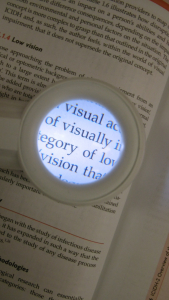
Accessibility is almost routine in public life. Handicapped parking, wheelchair ramps, curb cuts, accessible bathrooms, and Braille signage are in public places and many private ones, too, thanks to the Americans with Disabilities Act (ADA).

Photo: Andrzej Rembowski/Pixabay
Of course, there were no websites back then. It wasn’t until 2008 that new legislation was added to the ADA to instruct them to adopt accessibility tools.
But ADA compliance is far from a reality for most websites – even those owned by government agencies.
Many Websites are Required to be ADA-Compliant but…
Your website should be ADA-compliant if it represents a government or receives funding from a government, according to AudioEye, a business with the goal of “eradicating every barrier to digital access.”
The reality, though, is that this hasn’t happened everywhere. A 2021 article in WP Tavern detailed how Colorado became the first state to require state and local websites to be ADA-compliant. Clearly, states haven’t been focused on this, which is a little surprising considering how many offices closed during the COVID-19 pandemic and still require people to go online to access services, including – ironically – disability support.
Each agency in Colorado was instructed to submit an accessibility plan by July 1, 2022, and be fully compliant with the ADA by July 1, 2024. Those agencies that don’t meet the latter goal can be sued by a person with a disability for a $3500 fine.
Does that sound disturbing? Sometimes it’s the only way to get compliance going.
President Biden had WhiteHouse.gov relaunched to be compatible with current ADA standards according to its accessibility statement. His predecessor declined to enforce ADA deadlines ad even withdrew guidance. That action has been reversed.
ADA-Compliant Websites are Better for Everyone
Why would I say this? It’s simple: we all will eventually need some kind of support as we age.
We will all need some kind of support as we age. We can thank ADA for taking us there.
Let’s at least agree to make these steps a normal practice for websites:
- Add tools that enlarge fonts or allow a black/white contrast
- Add alt text to images that are read out loud on screen readers

Photo: bspence81 /Pixabay
These are pretty minimal steps, and it’s worth noting that search engines read alt text to understand images, which adds a little bit more SEO muscle to your website.
Many people with low vision use magnifiers to read newspapers and magazines. And guess what: taken as a whole, people with disabilities and their families and friends are potential customers. They work, buy stuff, go out to eat, and enjoy the same entertainment as the rest of us.
Why lose an opportunity for more sales?
These Tools Can Help You Get Your Website Moving Toward ADA Compliance
If you use WordPress, your site probably isn’t compliant, but a few hours of your time can bring it closer to the goal. It’s relatively easy to improve accessibility for people with visual disabilities if not actually meet ADA compliance goals.
A Google search for “ADA website tools” will identify articles, tools, and experts to help you understand what to do to make your site more accessible.
I’m a small business and do not run a place of public accommodation, so I don’t have to concern myself about ADA rules on this aspect. But I have taken steps to make my website a friendlier place for a person with limited vision to visit. Maybe they’ll think, hmm, I wonder if I should contact her for my blog or to freshen my stale site content? (Yes, please contact me.)
WordPress has a number of plugins that provide everything from testing your site to identifying ADA gaps to providing general and very specific fixes. You can search the WordPress theme repository for ADA-compliant themes. (Be sure to refresh if you use this link.) WordPress’s own accessibility team posts updates and recommends tools to boost accessibility.
ADA Website Compliance Tools
I’m not in a position to recommend tools, but I know these come from reliable sources.
- W3 Web Accessibility Evaluation Tools – list of tools that rate color contrasting, HTML markup code accessibility, Safari extensions, and more
- Accessibility Works testing and auditing tools
- Usability Geek’s 8 Free Web-Based Accessibility Evaluation Tools
Making websites fully compliant isn’t easy for those of us who aren’t techies. But making them easier for people with low vision to navigate is pretty easy.
I added the UserWay accessibility tool that makes reading this site a little easier for people with visual disabilities as well as those with dyslexia. It allows users to adjust contrast, increase text size, and increase spacing. I hope people find it useful. And of course, I add alt content to every image and link on my website.
For my previous site, I installed the WordPress Accessibility Toolbar that let visitors create a black/white contrast or enlarge the font.
The toolbar also comes with a menu that lets you select additional features to fix potential accessibility issues, such as forcing underlining on links and preventing links from opening in new windows, which can make browsing difficult for people with low vision.
The ADA Changed America for the Better
The ADA, of course, literally opened American doors to persons with disabilities. And that’s a good thing.
- Curb cuts and wider doors let people who use wheelchairs (and later, scooters) get around more easily.
- Braille readouts on ATMs, elevators, and directories allow people with low or no vision to molly participate in commerce.
- Close-captioning tools bring more deaf people into worksites, cinemas, and theaters.
A lot of ADA adaptations help the public at large, too Curb cuts are helpful to parents pushing strollers and kids learning how to ride a bike. What parent or caregiver hasn’t used an accessible restroom stall to keep a little one close by and change clothes and/or diapers?
ADA also made us work more intelligently.
Think about innovations like IM, texting, and other person-to-person communications that helped office communications and cut down on chatter which makes it hard to write. They also reduced the instances of the embarrassing or annoying “reply to all” on email.
I remember reading about a deaf colleague in New Orleans who was stranded during Hurricane Katrina. She worried about using up her cell phone battery as she tried to contact a sister outside the state via the TTY tool. Mobile communications were jammed, and calls couldn’t get through—but texting used minimal power. She eventually got through to her sibling as she walked (yes, walked) to the airport to catch a flight out. Guess who came for dinner?




